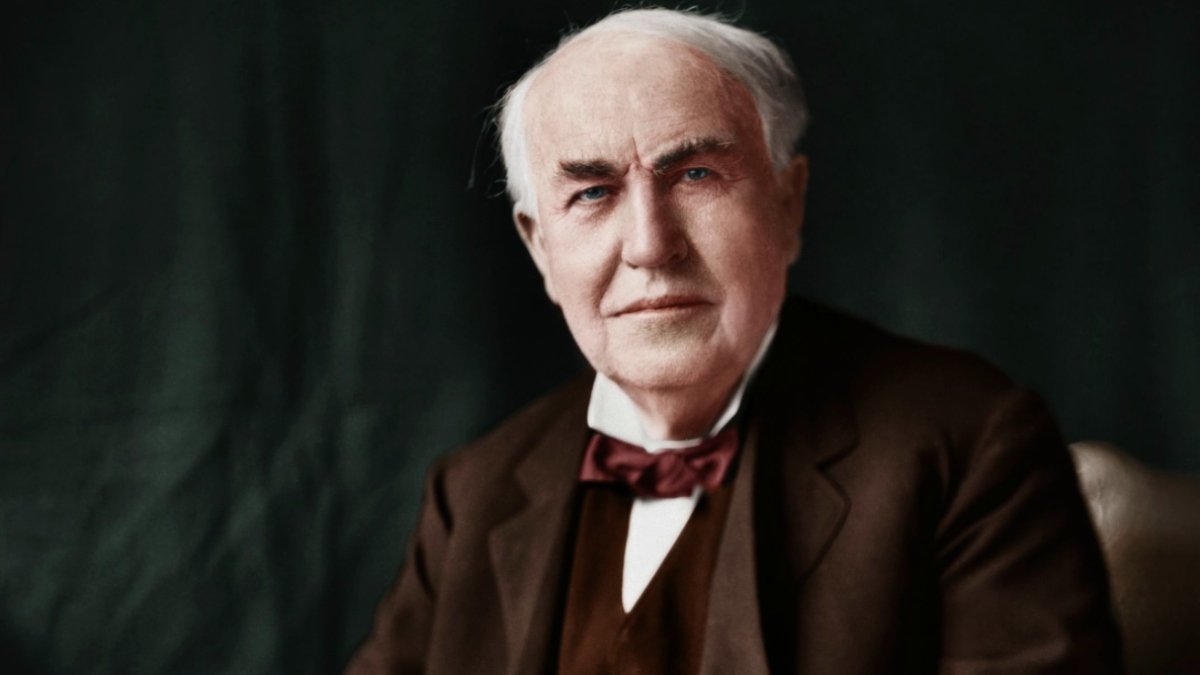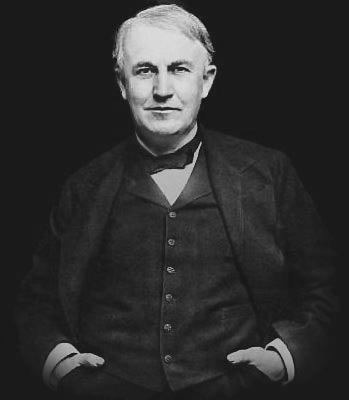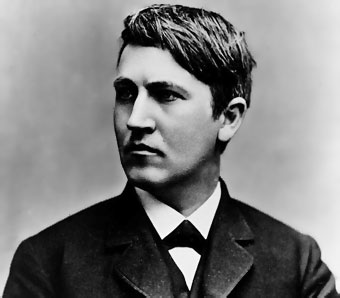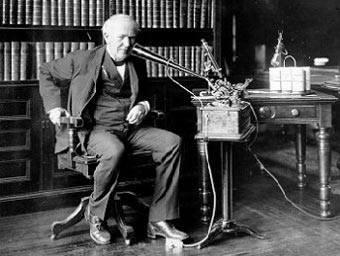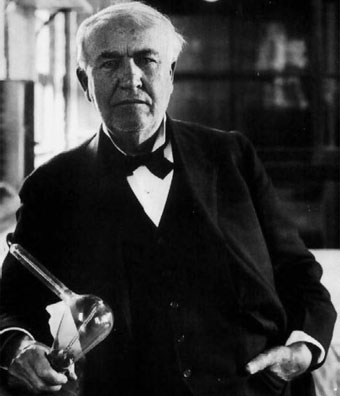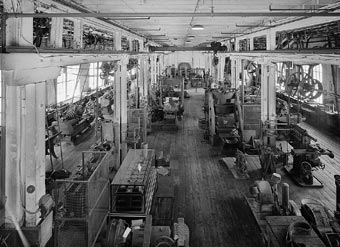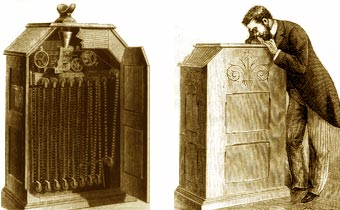Thomas Alva Edison, the youngest of four children, was born on February 11, 1847, in Milan, a small town in Ohio where his father, Samuel Edison, had settled six years earlier. His father had to hastily leave Canada as a result of a rebellion against the English in which he took part and which ended in failure. Marginalized by the railroad, activity in Milan gradually declined, and the crisis affected the Edison family, who had to emigrate again to a more prosperous place when their son Thomas had already reached the age of seven.
Thomas Alva Edison
The new place of residence was Port Huron, Michigan, where the future inventor first attended school. This was a very brief experience: it lasted only three months, after which he was expelled from the classrooms, his teacher alleging a complete lack of interest and a more than obvious clumsiness, behaviors to which partial deafness was not alien to him. contracted in the aftermath of a scarlet fever attack.
His mother, Nancy Elliot, who had worked as a teacher before getting married, henceforth assumed the education of the young youngest of the family, a task she carried out with no little talent since she managed to inspire in him that boundless curiosity that would be the characteristic most remarkable of his career throughout his life.
At the age of ten, little Thomas installed his first laboratory in the basements of his parents’ house and taught himself the rudiments of chemistry and electricity. But at the age of twelve, Edison also realized that he could exploit not only his creative capacity but also his keen practical sense. So, without forgetting his passion for experiments, he considered that it was in his power to earn hard cash by materializing some of his good ideas.
His first initiative was to sell newspapers and trinkets on the train from Port Huron to Detroit. The Civil War had broken out and travelers were hungry for news. Edison persuaded the railroad telegraphers to post short headlines on the development of the war on the station bulletin boards, not forgetting to add to the caption that the full details appeared in the newspapers; These newspapers were sold by Edison himself on the train, and it goes without saying that they were taken from his hands.
At the same time, he was incessantly buying scientific magazines, books, and gadgets, eventually turning the convoy’s baggage car into a new laboratory. He learned to telegraph and, after getting cheap and second-hand a printing press, began publishing a newspaper of his own, the Weekly Herald. One night, while he was working on his experiments, a bit of spilled phosphorus started a fire in the car. The train conductor and the conductor managed to put out the fire and then they threw the printing tools, the bottles and the thousand pots that packed the van out of the windows. The entire laboratory and even the inventor himself went to the road. Thus ended the first business of Thomas Alva Edison.
Young Edison was only sixteen when he decided to leave his parents’ home. The population in which he lived was already too small for him. Not lacking in initiative, he set out in search of new horizons. Luckily, he had a good command of the telegraph profession, and the civil war had left many vacancies, so wherever he went, it would be easy for him to find work.
Edison in 1878
For the next five years, Edison led a wandering life, from town to town, with odd jobs. He lodged in sordid pensions and invested all that he earned in acquiring books and apparatus for experimentation, totally neglecting his personal appearance. From Michigan to Ohio, from there to Indianapolis, then Cincinnati, and a few months later Memphis, having passed through Tennessee before.
His next job was in Boston, as a telegrapher on the night shift. He arrived there in 1868, and shortly after his twenty-first birthday he was able to acquire the work of the British scientist Michael Faraday Experimental Researches in Electricity, whose reading influenced him very positively. Until then, he had only earned the reputation of having a certain magical gift that allowed him to easily fix any faulty device. Now, Faraday provided him with the method to channel all his inventive genius. He became more orderly and disciplined, and from then on he acquired the habit of carrying a notebook with him, always ready to jot down any idea or fact that required his attention.
Convinced that his professional goal was an invention, Edison left the job he held and decided to become a freelance inventor, registering his first patent in 1868. It was an electric vote counter that he offered to Congress, but the members of the House described the apparatus as superfluous. The American inventor never forgot this lesson: an invention, above all else, must be necessary.
Without a real in his pocket, Edison arrived in New York in 1869. A friend provided him accommodation in the basements of the Gold Indicator Co., an office that telegraphically transmitted to its subscribers the quotations of the New York Stock Exchange. Shortly after his arrival, the transmitting apparatus broke down, causing quite a stir, and he volunteered to repair it, succeeding with astonishing ease. In return, he was entrusted with the technical maintenance of all the company’s services.
But since he was not interested in sedentary jobs, he took the first opportunity presented to him to work on his own again. Very soon he received a commission from Western Union, the most important telegraph company of that time. He was urged to build an effective stock price printer. His answer to this challenge was his first great invention: the Edison Universal Stock Printer. They offered him $40,000 for the device, an amount that finally allowed him to settle down. He married Mary Stilwell in 1871, with whom he had two sons and a daughter, and set up a small but well-equipped workshop in Newark, New York, where he continued to experiment with the telegraph in search of further refinements and applications. His greatest contribution in that field was the quadruple system, which allowed four telegraphic messages to be transmitted simultaneously on the same line, two in one direction and two in another.
Menlo Park Laboratory
Edison soon set out to build a real research center, an “invention factory,” as he called it, with a laboratory, library, workshops, and homes for himself and his collaborators, in order to carry out no matter what research, as long as they were practical, whether commissioned or out of sheer personal interest. The economic resources were not lacking and the proportions of his projects demanded it. He looked for a quiet place on the outskirts of New York until he found an uninhabited farm in the small town of Menlo Park. It was the place chosen to build their new headquarters, the world’s first research laboratory, where inventions would come from that would change the habits of a large part of the planet’s inhabitants.
He settled there in 1876 (he was then twenty-eight years old), and immediately went to work. The search for a satisfactory telephone transmitter claimed his attention. The one invented by Alexander Graham Bell, although theoretically well-conceived, generated such a weak current that it was not suitable for general applications. He knew that graphite particles, depending on whether they were held more or less tightly, influenced electrical resistance, and he applied this property to create a device that considerably amplified the weakest sounds: the carbon granule microphone, which he patented in 1876.
Edison with his dictaphone, one of the
applications derived from the phonograph
It was common in Edison for one job to lead to another, and the previous case was no exception. While trying to refine Bell’s telephone, he observed a fact that he was quick to describe in his notebook: “I just did an experiment with a diaphragm that has a blunt tip resting on fast-moving paraffin paper. The vibrations of the human voice are printed cleanly, and there is no doubt that I will be able to automatically pick up and reproduce any audible sound when I get to work on it. So freed from the phone, it was time to get on with it. A cylinder, a diaphragm, a needle and other minor tools were enough for him to build the phonograph, the most original of his inventions, in less than a year.
Edison himself was surprised by the simplicity of his invention, but he soon forgot about it and turned to the problem of electric lighting, the solution of which he found more interesting. “I will provide light so cheap,” Edison stated in 1879, “that not only the rich will be able to burn their spark plugs.” The answer lay in the incandescent lamp. It was known that certain materials could become incandescent when an electric current was applied to a balloon deprived of air. It only remained to find the most suitable filament. That is a metallic conductor that could be heated to incandescence without melting, staying in this state for as long as possible.
Before Edison, many other investigators worked in this direction, but when he joined he did so without haggling. He worked with filaments of the most different species: platinum, which he dismissed as expensive, carbon, soot and other materials, and even sent his collaborators to Japan, South America and Sumatra to gather different varieties of vegetable fibers before choosing the material. which he deemed more convenient. The first of its lamps was ready on October 21, 1879. It was a carbonized bamboo filament bulb, which exceeded forty hours of uninterrupted operation. The news of the event sent the shares of the gaslighting companies plummeting.
With the invention that made him famous (c. 1918)
In successive years, Edison busied himself with improving his light bulb, and it was this activity that led him to the only one of his discoveries that belongs to a strictly scientific area. It happened in 1883, while he was trying to figure out why his incandescent lamp was turning black with use. In the course of such investigations, the prolific inventor witnessed the manifestation of a curious phenomenon: the lamp emitted a bluish glow when subjected to certain vacuum conditions and certain voltages were applied to it. Edison found out that such light emission was caused by the inexplicable presence of an electric current that was established between the two rods that held the filament of the lamp, and he used this phenomenon, which received his name, to conceive an electric meter whose patent he registered in 1886.
In fact, Edison may have made the move from electrical engineering to electronics here. However, he did not know how to gauge the importance of the discovery. His method, closer to “trial and error” than to scientific deduction, prevented him from doing so. It was necessary to wait for the British engineer John Ambrose Fleming, a technologist with solid scientific training, to take the step in 1897 when he managed, after discreet modifications, to transform Edison’s electric meter into the vacuum valve, the first in a long series of electrical devices that gave rise to a new technological era.
More than a thousand inventions
In 1886, two years after his wife passed away, Edison married Mina Miller, a strong-willed woman, the daughter of a wealthy Akran, Ohio, industrialist, whose influence on her eccentric husband was noted as she succeeded in making him a more sociable person. The marriage had three children, one of whom, Charles, became a politician, eventually becoming governor of the state of New Jersey.
Within a year of getting married, Edison moved his laboratory from Menlo Park, then small, to West Orange, New Jersey. He created there a great technological center, the Edison Laboratory (today a national monument), around which he built numerous workshops, employing more than five thousand people.
One of the West Orange workshops
Electricity continued to absorb most of his time, taking care of all aspects of its production and distribution. Not with much luck, however, since he made a serious mistake in insisting on the direct current system when there were compelling reasons in favor of alternating current. Edison was also interested in many other industrial sectors: the production of cement and chemical materials, the electromagnetic separation of iron and the manufacture of batteries and accumulators for automobiles were some of his favorites.
His last great invention was the Kinetograph, whose patent he registered in 1891. It was a rudimentary film camera that included, however, an ingenious mechanism to ensure the intermittent movement of the film. In 1894 Edison opened the Kinetoscope Parlor on Broadway, New York, where a single spectator sat in front of a peephole in a wooden booth to watch the film, which was lit from behind by an electric lamp. Although the Kinetoscope Parlor immediately attracted attention as a fairground attraction, Edison never believed that it was important to find a projection system for larger audiences, which prevented him from taking the definitive step into the cinema of the Lumière brothers.
The Kinetoscope Parlor
The activity of this brilliant inventor lasted beyond the age of eighty, completing the list of his technological achievements to a total of 1,093 patents that he registered while alive. Arteriosclerosis, however, was undermining the health of this restless old man, whose death took place on October 18, 1931, in West Orange, New Jersey.




